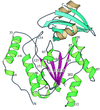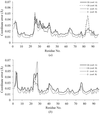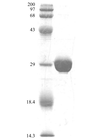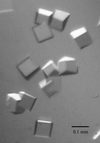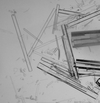issue contents
August 2002 issue

Cover illustration: Surface electrostatic potentials of ![[beta]](/logos/entities/beta_rmgif.gif) -CIN (top) and
-CIN (top) and ![[beta]](/logos/entities/beta_rmgif.gif) -CRY (bottom), front (left-hand side) and back (right-hand side) views. Negatively charged regions are represented in red and positively charged regions in blue, p. 1314.
-CRY (bottom), front (left-hand side) and back (right-hand side) views. Negatively charged regions are represented in red and positively charged regions in blue, p. 1314.
research papers
Metal-free S100A3, a cysteine-rich Ca2+- and Zn2+-binding protein, has been crystallized by vapour diffusion under the strict exclusion of oxygen and in the absence of divalent metal ions. The structure was solved by MIRAS phasing using potassium iodide and xenon derivatives.
PDB reference: apo-S100A3, 1kso, r1ksosf
Multi-wavelength anomalous dispersion using brominated derivatives is considered a common and convenient technique for solving chemically synthesized nucleic acid structures. Here, it is shown that a relatively moderate X-ray dose can induce sufficient debromination to prevent structure determination.
A comparative study involving the structures reported here and similar known structures show that the mobility of the UDG molecule consists of the rigid-body movement of the two domains that make up the molecule and the flexibility within the domains. DNA binding leads to domain closure, while association with the proteinaceous inhibitor does not.
A new formulation of direct methods using the sign probability originally introduced for breaking the phase ambiguity has been proposed, in which the known phase information could be used as constrained phases in the phase refinement. This new formulation has been applied to protein crystallographic phase extension and shown to be effective.
A computationally efficient formulation is presented that significantly accelerates the rotational search in biomolecular matching problems. This is achieved by means of a new set of parameters that allows Fourier transformation of all three rotational degrees of freedom.
The structures of GAPDH complexed with coenzyme analogues ADP-ribose and SNAD+ have been determined by molecular replacement. SNAD+–GAPDH reveals significant molecular asymmetry in the crystalline state.
The structures of cytochrome b5 mutants V45E and V45Y reveal that the large side chains of Glu45 and Tyr45 of the mutants point to solvent instead of pointing to heme, leading to a decrease in the hydrophobicity of the heme pocket. The rotation of the porphyrin ring and the conformational change of the axial ligand His39 in the V45Y mutant indicate that the microenvironment of the heme is disturbed owing to the mutation.
The structure of recombinant RNase Sa from 1.0 Å spacing synchrotron data collected at cryogenic temperature shows two alternative conformations of the main chain in two loops which contain active-site residues. This feature was not observed in the structure refined against room-temperature data at 1.2 Å resolution.
PDB reference: RNase Sa, 1lni, 1lnisf
The X-ray structure of an elicitin, β-cinnamomin, secreted by the phytopathogenic fungus P. cinnamomi has been determined by the molecular-replacement method and refined to 1.8 Å resolution.
PDB reference: β-cinnamomin, 1ljp, r1ljpsf
The crystal structure of creatine amidinohydrolase from Actinobacillus has been determined by the molecular-replacement method and refined to 2.7 Å resolution.
PDB reference: creatinase, 1kp0, r1kp0sf
crystallization papers
The 24 kDa CyoA soluble domain of Vitreoscilla cytochrome bo quinol oxidase has been crystallized from a solution of 2 M ammonium sulfate and 5% 2-propanol. The crystals belong to space group P4332 with a = 122.2 Å and contain one CyoA subunit per asymmetric unit.
Saccharomyces cerevisiae alcohol dehydrogenase I crystallizes in space group P3121 or P3221 and diffracts to 3.0 Å resolution. A fluorescence scan of the crystal produced a peak at 9671.6 eV, suggesting the presence of Zn2+ ions in the crystal.
The enzyme alliinase has been isolated from garlic bulbs and crystallized. The crystals belong to space group P21, with unit-cell parameters a = 70.191, b = 127.006, c = 108.085 Å, β = 93.384°.
Glutamate dehydrogenase from an aerobic hyperthermophilic archaeon, A. pernix K1, has been crystallized. Diffraction data sets have been collected at 3.0 Å resolution.
Crystallization conditions have been established to produce high-quality crystals of the TRAF domain of TNF-receptor-associated factor TRAF3 that are suitable for structural studies of the factor alone or in complex with peptides from the interacting regions of TNF receptors.
A new crystal form of EcoRII, a type IIe restriction endonuclease, has been grown. Crystals of the new monoclinic form diffract to 2.8 Å resolution.
The stepwise optimization of crystallization conditions, characterization by X-ray diffraction and space-group changes upon heavy-atom derivatization of a rhamnogalacturonan lyase from A. aculeatus are reported.
CarAa, the terminal oxygenase component of carbazole 1,9a-dioxygenase from P. resinovorans strain CA10, has been crystallized and diffraction data have been collected to 3.0 Å resolution.
The PDZ domain of Shank1 from R. norvegicus has been crystallized in peptide-free form and in complex with the C-terminal octapeptide of GKAP. Native and complex crystals belong to space group P21 and P212121 and diffract to 1.8 and 3.2 Å resolution, respectively.
The creatinine-hydrolysing enzyme creatininase was crystallized successfully for the first time. The crystals diffract X-rays to at least 2.5 Å resolution.
The FERM domain of the cytoskeletal–plasma membrane linker molecule ezrin has been crystallized. The monoclinic crystals diffract to 2.3 Å resolution.
The transcriptional regulator TraR from A. tumefaciens has been crystallized in complex with its activating molecule, the pheromone N-3-oxooctanoyl-L-homoserine lactone (AAI), and with its target DNA sequence, an 18-base pair DNA sequence called TraBox. A three-wavelength MAD data set, using seleno-L-methionine-substituted crystals, has been collected to a resolution of 3 Å.
Quinone oxidoreductase from T. thermophilus HB8 was overproduced in E. coli and then crystallized in the absence and presence of NADPH.
The actin-binding domain of plectin, a cytolinker protein, was expressed, purified and crystallized. Monoclinic crystals diffracted to 2.0 Å resolution using synchrotron radiation.
The 16 kDa matrix protein of the Borna disease virus envelope expressed in E. coli crystallizes in the space group I432, with unit-cell parameters a = b = c = 144.6 Å. The crystals diffract to 3.1 Å.
α-Galactosidases catalyze the hydrolysis of galactooligosaccharides and galactopolysaccharides to α-galactose residues. α-Galactosidase from rice (O. sativa L. ssp. japonica) was crystallized and X-ray data were collected at 1.9 Å resolution.
The 43 kDa ATPase domain of T. thermophilus gyrase B was overproduced in Escherichia coli and a three-step purification protocol yielded large quantities of highly purified enzyme which remained stable for weeks. Crystals of the 43 kDa domain in complex with novobiocin, one of the most potent inhibitors of bacterial topoisomerases, were obtained.
Orthorhombic crystals of human L-xylulose reductase were grown from buffered polyethylene glycol solutions and diffract to 2.1 Å resolution.
short communications
The crystal structure of a hexameric DNA fragment with the sequence d(TGCGCA)2 has been solved and refined at 293 K at a resolution of 1.64 Å. A comparison of the present structure with that at low temperature and with that of d(CGCGCG)2 throws light on the effects of the sequence and of temperature on the duplex structure of Z-DNA hexamers.
NDB reference: d(TGCGCA)2, ZD0007
A World Wide Web-based graphical user interface has been developed to manipulate the protein structures available in the Protein Data Bank.


 journal menu
journal menu













